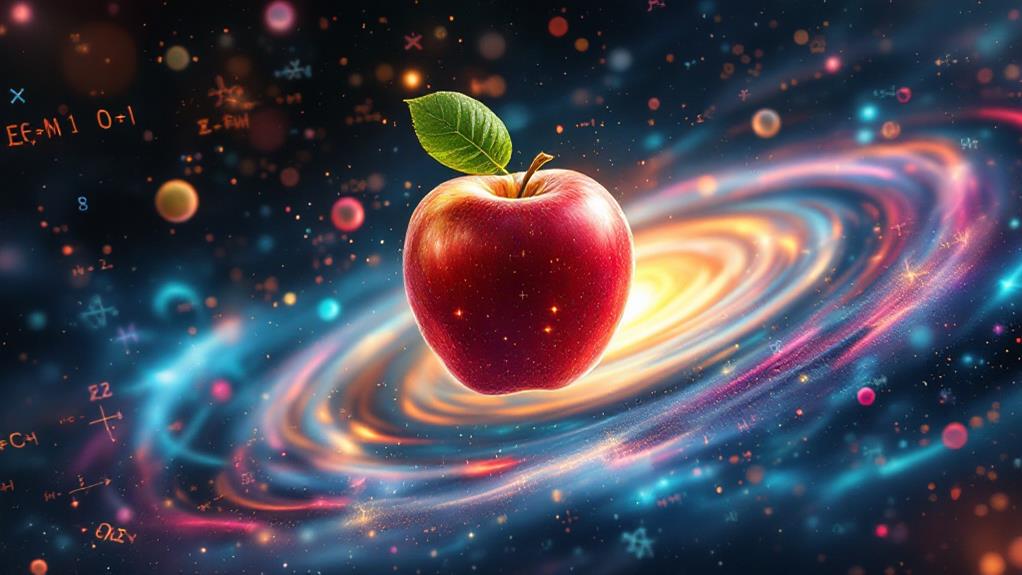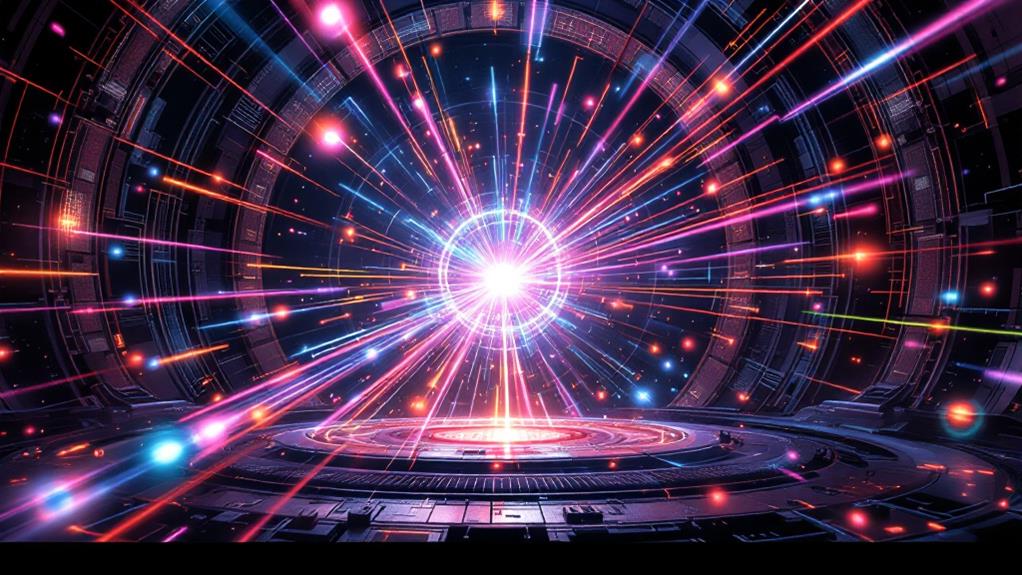Fascinating Quantum Physics Facts: Understanding the Universe at the Smallest Scale

Quantum physics reveals a mind-bending world where particles exist in multiple states simultaneously (superposition), behave as both waves and particles, and can instantly influence each other across vast distances (entanglement). You'll encounter particles tunneling through seemingly impenetrable barriers and the bizarre notion that observing a particle affects its behavior. The Heisenberg Uncertainty Principle states you can't precisely measure both a particle's position and momentum. Some interpretations even suggest the existence of infinite parallel universes. Quantum mechanics also underlies modern technology, from lasers to MRI machines. Prepare to have your understanding of reality challenged as you investigate the quantum domain.
Quantum Superposition
Quantum superposition is a fundamental principle in quantum mechanics that defies our everyday understanding of reality. It suggests that a particle can exist in multiple states simultaneously until it's observed or measured. You might find this concept mind-boggling, but it's essential to understanding the quantum world.
Imagine a coin spinning in the air. While it's spinning, you can't tell if it's heads or tails – it's in a superposition of both states. Similarly, quantum particles can be in multiple states at once. This property allows quantum computers to perform complex calculations much faster than classical computers.
However, quantum superposition is fragile. When a quantum system interacts with its environment, it undergoes quantum decoherence, causing the superposition to collapse. This is why quantum experiments are often conducted in isolated environments.
Quantum measurement also plays a pivotal role in superposition. When you measure a quantum system, you force it to "choose" a single state, collapsing the superposition. This phenomenon, known as wave function collapse, is central to many interpretations of quantum mechanics and continues to puzzle scientists today.
Wave-Particle Duality
Light, the essence of our visual world, embodies one of quantum physics' most perplexing concepts: wave-particle duality. This principle states that all matter and energy exhibit both wave-like and particle-like properties, depending on how you observe them. You might wonder how something can be both a wave and a particle simultaneously, but that's the beauty of quantum mechanics.
When you shine light through a double-slit experiment, you'll see interference patterns, a telltale sign of wave behavior. However, when you detect individual photons, they arrive as discrete particles. This seemingly contradictory nature is known as wave-particle complementarity, a fundamental aspect of quantum physics.
Electrons, protons, and even entire molecules display this dual nature. You can't observe both wave and particle properties simultaneously; the act of measurement influences the outcome. This duality challenges your classical understanding of reality and forces you to welcome a more probabilistic view of the universe. It's not just a quirk of light; it's a fundamental property of all matter and energy, shaping the very fabric of our quantum world.
Quantum Entanglement
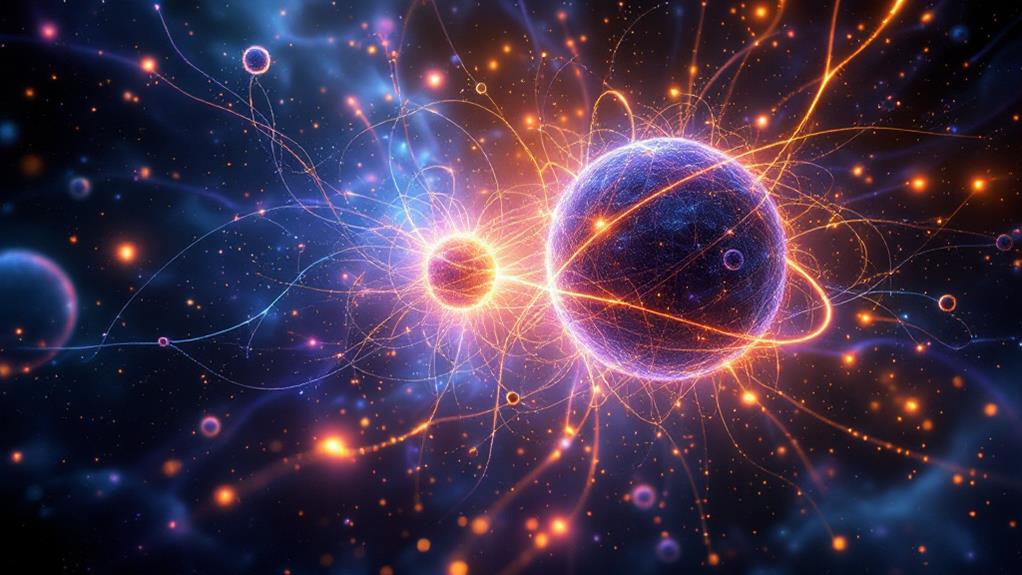
Often described as "spooky action at a distance," quantum interconnectedness is a phenomenon that defies our everyday understanding of reality. When two particles become intertwined, their quantum states are inextricably linked, regardless of the distance between them. This means that measuring one particle instantly affects its entangled partner, even if they're light-years apart.
You might wonder how this is possible. The key lies in quantum nonlocality, which allows for faster-than-light communication between entangled particles. It's as if they share a secret connection that transcends space and time. This bizarre behavior has been experimentally verified, leaving scientists both amazed and puzzled.
Quantum entanglement has potential applications in quantum computing, cryptography, and teleportation. However, it's incredibly delicate. Quantum decoherence, the loss of quantum properties due to interaction with the environment, can quickly destroy entanglement. Scientists are working hard to maintain entangled states for longer periods, which could revolutionize technology and our understanding of the universe.
As you explore deeper into quantum physics, you'll find that entanglement challenges our classical notions of causality and locality, opening up a world of mind-bending possibilities.
Heisenberg Uncertainty Principle
At the heart of quantum mechanics lies one of its most famous and fundamental principles: the Heisenberg Uncertainty Principle. Named after physicist Werner Heisenberg, this principle states that you can't simultaneously measure both the position and momentum of a particle with perfect accuracy. The more precisely you determine one property, the less precisely you can know the other.
This principle isn't just about measurement limitations; it's a fundamental aspect of nature. It suggests that particles don't have definite properties until they're observed, leading to the concept of wave function collapse. When you measure a particle's position, for instance, you're fundamentally forcing it to assume a specific state, affecting its momentum in the process.
The Heisenberg Uncertainty Principle also relates to the observer effect, where the act of observation itself influences the system being observed. This challenges our classical understanding of reality, implying that the universe is inherently probabilistic rather than deterministic. It's a cornerstone of quantum mechanics that continues to puzzle and fascinate scientists, highlighting the strange and counterintuitive nature of the quantum world.
Quantum Tunneling
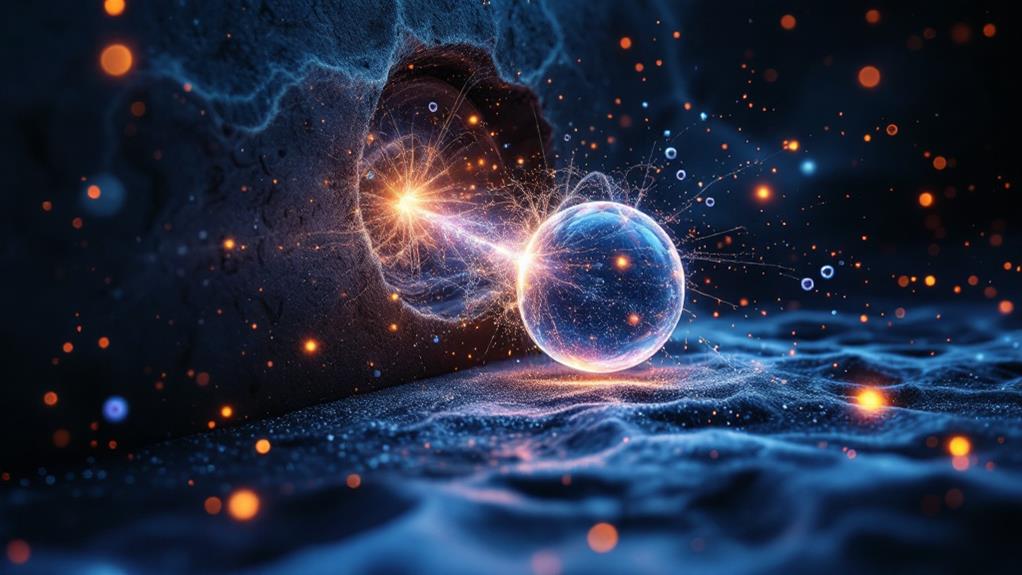
Quantum tunneling is a mind-bending phenomenon where particles can pass through barriers they shouldn't be able to overcome. This counterintuitive behavior occurs at the quantum level, where particles exhibit wave-like properties. When a particle encounters a barrier, its wavefunction extends beyond the obstacle, giving it a small probability of appearing on the other side.
You might wonder how this is possible. In classical physics, it's comparable to a ball rolling up a hill without enough energy to reach the top. But in the quantum world, particles can "tunnel" through the barrier as if it weren't there. This process doesn't involve the particle physically breaking through; instead, it's a result of the probabilistic nature of quantum mechanics.
Quantum tunneling plays an indispensable role in various phenomena, from nuclear fusion in stars to the operation of scanning tunneling microscopes. It's also responsible for radioactive decay and certain types of chemical reactions. The concept of particle interference is closely related to tunneling, as both phenomena arise from the wave-like nature of quantum objects. When a particle tunnels, it's as if its wavefunction collapses on the other side of the barrier, defying classical expectations.
Quantum Teleportation
The mystery of quantum teleportation enthralls scientists and sci-fi enthusiasts alike. You might think it's about beaming objects across space, but it's actually the transfer of quantum information from one location to another. This process relies on the principle of quantum linkage, where two particles are linked regardless of distance.
In quantum teleportation, you're not moving matter but transmitting the exact quantum state of one particle to another. This involves three particles: the one to be teleported and an linked pair. By performing specific measurements on the original particle and one of the linked pair, you can recreate the original particle's state in the third particle.
Quantum decoherence, the loss of quantum properties due to interaction with the environment, poses a significant challenge to this process. Scientists work to minimize decoherence to maintain the delicate quantum states. Another concept, quantum discord, measures quantum correlations beyond linkage and plays a role in understanding the efficiency of quantum teleportation. While we're far from Star Trek-style transporters, quantum teleportation has practical applications in quantum computing and secure communication networks.
Many-Worlds Interpretation

While quantum teleportation deals with information transfer, the Many-Worlds Interpretation (MWI) tackles the nature of reality itself. Proposed by Hugh Everett III in 1957, this controversial theory suggests that every quantum event creates multiple parallel universes.
According to MWI, when you make a decision or observe a quantum system, the universe splits into different versions, each representing a possible outcome. This means that all potential states of a quantum system exist simultaneously in separate, but equally real, universes.
The theory attempts to resolve the paradox of quantum superposition, where particles can exist in multiple states until observed. Instead of collapsing into a single state, MWI proposes that all possible states continue to exist in different branches of reality.
Critics argue that MWI lacks empirical evidence and violates Occam's Razor by unnecessarily multiplying entities. However, proponents claim it gracefully explains quantum phenomena without requiring a collapse of the wave function.
MWI also suggests that quantum fluctuations could lead to the creation of new universes, potentially explaining the origins of our own cosmos. While unproven, this interpretation continues to fascinate physicists and philosophers alike.
Quantum Coherence
From the mind-bending concept of parallel universes, we shift our focus to a fundamental property of quantum systems: coherence. Quantum coherence refers to the ability of particles to exist in multiple states simultaneously, maintaining a specific phase relationship. This phenomenon is pivotal for quantum computing and other applications of quantum mechanics.
You'll find that coherence is fragile and easily disrupted by interactions with the environment, a process known as quantum decoherence. When decoherence occurs, the quantum system loses its unique properties and begins to behave more like classical objects. This transition from quantum to classical behavior is closely related to the quantum measurement problem.
To understand quantum coherence better, consider these key points:
- Coherence allows quantum systems to exist in superposition states
- It's essential for quantum entanglement and interference effects
- Preserving coherence is a major challenge in quantum technology development
You might wonder how scientists preserve quantum coherence. They use various techniques, such as cooling systems to near-absolute zero temperatures, isolating particles from external disturbances, and employing error correction algorithms. By becoming proficient in these methods, researchers hope to harness the power of quantum coherence for revolutionary technologies like quantum computers and ultra-precise sensors.
Zero-Point Energy
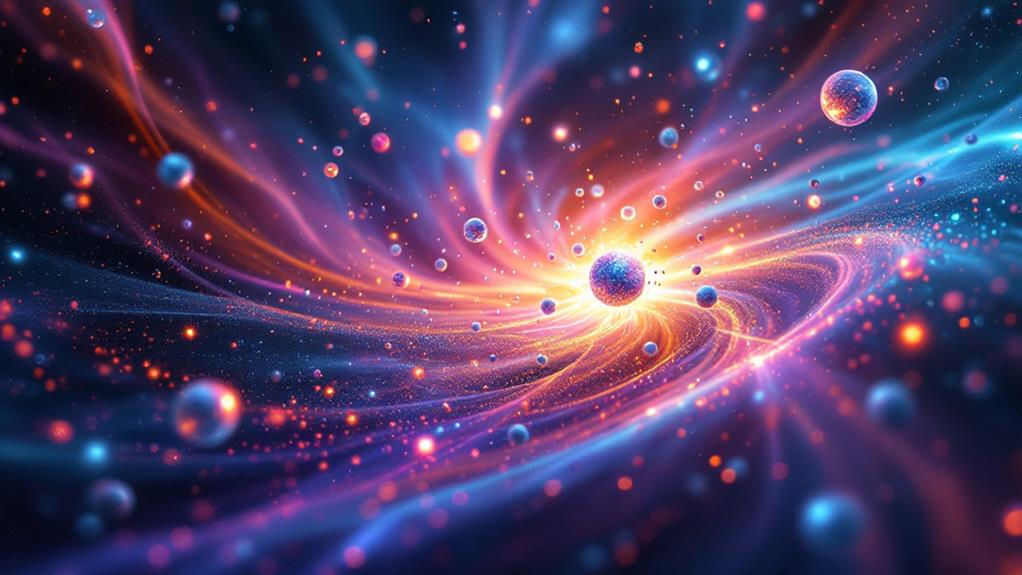
Imagine a universe where absolute stillness is impossible. That's the reality of zero-point energy, a fundamental concept in quantum physics. Even in the coldest, emptiest regions of space, there's a constant buzz of activity at the quantum level.
Zero-point energy refers to the lowest possible energy state of a quantum mechanical system. It's not zero, as classical physics might suggest, but a small, non-zero amount. This energy arises from vacuum energy fluctuations, where particles and anti-particles spontaneously pop in and out of existence.
You might wonder how this affects the world around you. While typically too small to notice, zero-point energy has real consequences. It contributes to the Casimir effect, where two uncharged metal plates in a vacuum experience a tiny attractive force. It also plays a role in spontaneous particle creation, where particles can appear seemingly out of nowhere.
Understanding zero-point energy challenges our classical notions of emptiness and stillness. It reveals a universe that's always in motion, even at its most fundamental level, and continues to fascinate physicists as they investigate its implications for our understanding of reality.
Quantum Computing
The domain of quantum computing stands at the frontier of technological innovation. It employs the principles of quantum mechanics to process information in ways that classical computers can't. Unlike traditional bits, quantum computers use qubits, which can exist in multiple states simultaneously, allowing for remarkable computational power.
Quantum supremacy, a milestone achieved in 2019, demonstrated that quantum computers could solve certain problems faster than classical supercomputers. This breakthrough has opened up new possibilities in various fields, including:
- Cryptography and cybersecurity
- Drug discovery and materials science
- Financial modeling and risk assessment
Qubit optimization is vital for improving quantum computer performance. Scientists are working on developing more stable qubits and reducing error rates to create practical, large-scale quantum systems. As researchers continue to refine quantum computing technology, we're inching closer to solving complex problems that were once thought unattainable.
You'll likely see quantum computing impact your life in the coming years, from more secure online transactions to personalized medicine. While still in its early stages, quantum computing promises to revolutionize how we process information and tackle global challenges.

